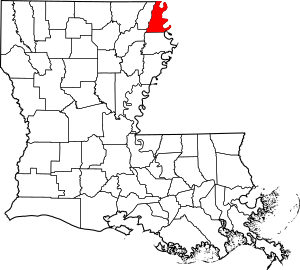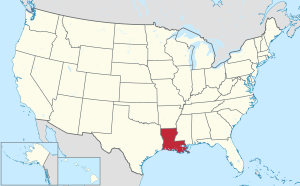East Carroll Parish, Louisiana facts for kids
Quick facts for kids
East Carroll Parish
|
|
|---|---|

East Carroll Parish Courthouse in Lake Providence
|
|

Location within the U.S. state of Louisiana
|
|
 Louisiana's location within the U.S. |
|
| Country | |
| State | |
| Founded | March 26, 1877 |
| Named for | Charles Carroll of Carrollton |
| Seat | Lake Providence |
| Largest town | Lake Providence |
| Area | |
| • Total | 442 sq mi (1,140 km2) |
| • Land | 421 sq mi (1,090 km2) |
| • Water | 22 sq mi (60 km2) 4.9% |
| Population
(2020)
|
|
| • Total | 7,459 |
| • Density | 16.876/sq mi (6.516/km2) |
| Time zone | UTC−6 (Central) |
| • Summer (DST) | UTC−5 (CDT) |
| Congressional district | 5th |
East Carroll Parish (which means "East Carroll Parish" in French) is a special kind of county called a parish in northeastern Louisiana. It's located in the Mississippi Delta, a flat area near the Mississippi River. In 2020, about 7,459 people lived here. The main town and government center is Lake Providence. A long time ago, this area was known for its cotton farms. Even today, about 74% of the land in East Carroll Parish is used for farming.
Contents
History of East Carroll Parish
This area is part of the delta along the western side of the Mississippi River. It has very fertile soil because of the river's yearly floods. For thousands of years, different indigenous peoples lived here. When European explorers arrived, they met tribes like the Caddo and Choctaw. The Natchez tribe lived on the east side of the Mississippi River.
Early Settlements and Farming
In the 1830s, the United States government made most of the Five Civilized Tribes move from the Southeast. They were sent to lands west of the Mississippi River, known as Indian Territory. This was done to open up land for European Americans to settle and farm. Areas along the river were cleared to grow cotton. Cotton was a very important crop in the Southern United States before the Civil War. Large groups of enslaved African-American people were forced to work on these cotton farms, called plantations.
Before 1814, all the land that is now East Carroll Parish was part of a parish called Warren Parish. The original Carroll Parish was named after Charles Carroll of Carrollton. He was from Maryland and was the only Roman Catholic person to sign the Declaration of Independence. This area and other nearby parishes along the Mississippi River were sometimes called the Natchez District. Both areas were important for growing cotton.
Life Before and After the Civil War
Because cotton farming relied on enslaved workers, most people in this area were African American even before the American Civil War. In 1860, Carroll Parish had 11,000 enslaved people. This was more than three times the number of white people in the whole parish. Most of these enslaved people lived on plantations near the Mississippi River. During the Civil War, many enslaved people joined the Union army. They served in groups like the United States Colored Troops. Louisiana had more former enslaved people join the USCT than six other Southern states combined.
After the war, this area remained mostly rural and focused on farming. Many black Union veterans settled in East Carroll Parish. Some even owned their own land, especially in an area called Soldiers' Rest, where a Union army camp used to be. They built their own independent community. Since black people outnumbered white people in Carroll Parish by a lot, they had a strong voice. In the 1870s, voters in the larger Carroll Parish elected black people to important jobs. These included sheriff, state representative, and clerk of the court. They also hired black constables, which gave black people power in local government.
However, white conservative Democrats formed groups that used violence against black voters and their supporters. These groups were called "Bulldozers." Their goal was to stop black people from being active in politics. White conservatives eventually took back control of the state government after the Reconstruction era ended. In 1877, the state legislature split Carroll Parish into two parts: East Carroll Parish and West Carroll Parish. West Carroll Parish, which was west of the Bayou Macon, had more white residents and voted for the Democratic party.
About twenty years later, in 1898, Louisiana passed a new state constitution. This constitution made it very hard for African Americans to register to vote. They were effectively prevented from voting until the 1960s. The state also passed laws that separated people by race, known as Jim Crow laws. These laws became stricter in the early 20th century.
President Roosevelt's Visit
In 1907, U.S. President Theodore Roosevelt visited East Carroll Parish. He came near Lake Providence for a black bear hunt. When one bear was hard to find, the president's camp moved to Bear Lake in Madison Parish. A 21-year-old named Arthur Spencer took a famous photograph of Roosevelt with his hunting group. Among the hunters was John M. Parker, who later became the governor of Louisiana.
Geography of East Carroll Parish
East Carroll Parish covers about 442 square miles. Most of this (421 square miles) is land, and about 22 square miles (4.9%) is water.
Main Roads
Neighboring Areas
East Carroll Parish shares borders with:
- Chicot County, Arkansas (to the north)
- Issaquena County, Mississippi (to the east)
- Warren County, Mississippi (to the southeast)
- Madison Parish (to the south)
- Richland Parish (to the southwest)
- West Carroll Parish (to the west)
Communities in East Carroll Parish
Towns
- Lake Providence (This is the only official town and the parish seat.)
Small Communities (Unincorporated)
These are smaller places that are not officially towns:
- Alsatia
- Gassoway
- Millikin
- Shelburn
- Sondheimer
- Transylvania
Old Settlements (No Longer Exist)
- Goodrich's Landing
Population and Economy
The population of East Carroll Parish has changed over the years. In 1880, there were 12,134 people. The population grew to a high of 19,023 in 1940. Since then, it has slowly decreased. In 2020, the population was 7,459.
East Carroll Parish is still mostly about farming. About 74% of its land is used for crops. However, new machines mean fewer people are needed for farm work. This has led to fewer jobs in the area. Farming here can include growing crops or raising fish (aquaculture).
In 2011, East Carroll Parish was ranked as one of the poorest counties in the U.S. It was estimated that 44% of the people living there were in poverty.
Education in East Carroll Parish
Public schools in East Carroll Parish are run by the East Carroll Parish School Board. An infographic from Graphiq once ranked East Carroll Parish as the least educated parish in Louisiana. This was based on the percentage of adults without a high school diploma and those with a college degree.
Notable People from East Carroll Parish
- Buddy Caldwell: He was the District Attorney for this area and later became the attorney general of Louisiana.
- William J. Jefferson: He was born in Lake Providence and served as a U.S. representative for Louisiana.
- Joseph Ransdell: A politician who served in Congress from 1913 to 1931. He lived in Lake Providence for many years.
- Norris C. Williamson: A state senator who worked to help cotton farmers and get money to fight cattle ticks.
- John D. Winters: A historian who wrote a book about The Civil War in Louisiana. He grew up in Lake Providence.
Images for kids
See also
 In Spanish: Parroquia de East Carroll para niños
In Spanish: Parroquia de East Carroll para niños






